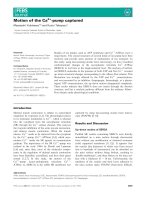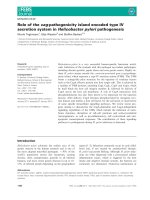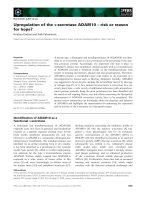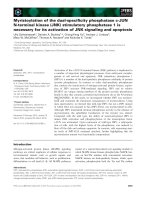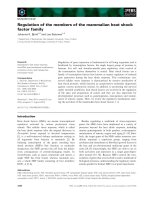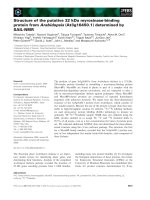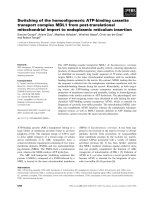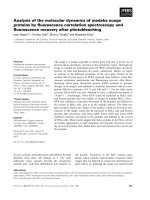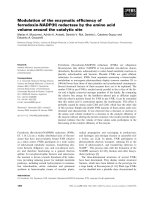Báo cáo khoa học: Paralog of the formylglycine-generating enzyme – retention in the endoplasmic reticulum by canonical and noncanonical signals pptx
Bạn đang xem bản rút gọn của tài liệu. Xem và tải ngay bản đầy đủ của tài liệu tại đây (1.95 MB, 13 trang )
Paralog of the formylglycine-generating enzyme –
retention in the endoplasmic reticulum by canonical and
noncanonical signals
Santosh Lakshmi Gande
1
, Malaiyalam Mariappan
1
, Bernhard Schmidt
1
, Thomas H. Pringle
2
,
Kurt von Figura
1
and Thomas Dierks
3
1 Zentrum fu
¨
r Biochemie und Molekulare Zellbiologie, Abteilung Biochemie II, Universita
¨
tGo
¨
ttingen, Germany
2 Sperling Foundation, Eugene, OR, USA
3 Fakulta
¨
tfu
¨
r Chemie, Biochemie I, Universita
¨
t Bielefeld, Germany
In the catalytic center of eukaryotic and prokaryotic
sulfatases, a unique amino acid, C
a
-formylglycine
(FGly), can be found that is essential for enzymatic
activity [1–5]. The FGly participates as an aldehyde
hydrate in the hydrolysis of sulfate esters according to
a novel trans-sulfation ⁄ elimination mechanism [5–9].
The FGly in all eukaryotic and in most prokaryotic
sulfatases is post-translationally generated by oxidation
of a specific cysteine residue and, in most cases, this
oxidation is catalyzed by the recently discovered form-
ylglycine-generating enzyme (FGE), a novel oxygenase
with unusual structural and catalytic properties
[10–15]. The genetic defect of FGE in human leads to
multiple sulfatase deficiency, a rare inherited disorder
Keywords
endoplasmic reticulum; formylglycine-
generating enzyme; KDEL receptor; protein
retention; SUMF2
Correspondence
T. Dierks, Fakulta
¨
tfu
¨
r Chemie, Biochemie I,
Universita
¨
t Bielefeld, Universita
¨
tsstr. 25,
33615 Bielefeld, Germany
Fax: +49 521 106 6014
Tel: +49 521 106 2092
E-mail:
Website: />chemie/bc1/bc1.htm
(Received 28 October 2007, revised 17
December 2007, accepted 4 January 2008)
doi:10.1111/j.1742-4658.2008.06271.x
Formylglycine-generating enzyme (FGE) catalyzes in newly synthesized sul-
fatases the oxidation of a specific cysteine residue to formylglycine, which
is the catalytic residue required for sulfate ester hydrolysis. This post-trans-
lational modification occurs in the endoplasmic reticulum (ER), and is an
essential step in the biogenesis of this enzyme family. A paralog of FGE
(pFGE) also localizes to the ER. It shares many properties with FGE, but
lacks formylglycine-generating activity. There is evidence that FGE and
pFGE act in concert, possibly by forming complexes with sulfatases and
one another. Here we show that human pFGE, but not FGE, is retained in
the ER through its C-terminal tetrapeptide PGEL, a noncanonical variant
of the classic KDEL ER-retention signal. Surprisingly, PGEL, although
having two nonconsensus residues (PG), confers efficient ER retention
when fused to a secretory protein. Inducible coexpression of pFGE at dif-
ferent levels in FGE-expressing cells did not significantly influence the
kinetics of FGE secretion, suggesting that pFGE is not a retention factor
for FGE in vivo. PGEL is accessible at the surface of the pFGE structure.
It is found in 21 mammalian species with available pFGE sequences. Other
species carry either canonical signals (eight mammals and 26 nonmammals)
or different noncanonical variants (six mammals and six nonmammals).
Among the latter, SGEL was tested and found to also confer ER retention.
Although evolutionarily conserved for mammalian pFGE, the PGEL signal
is found only in one further human protein entering the ER. Its conse-
quences for KDEL receptor-mediated ER retrieval and benefit for pFGE
functionality remain to be fully resolved.
Abbreviations
ER, endoplasmic reticulum; FGE, C
a
-formylglycine-generating enzyme; FGly, C
a
-formylglycine; PDI, protein disulfide isomerase;
pFGE, paralog of C
a
-formylglycine-generating enzyme.
1118 FEBS Journal 275 (2008) 1118–1130 ª 2008 The Authors Journal compilation ª 2008 FEBS
of a fatal nature that is characterized by the synthesis
of catalytically inactive sulfatases lacking FGly
[12,13,16,17]. All multiple sulfatase deficiency patients
analyzed so far carried mutations in the FGE-encoding
SUMF1 gene [12,13,18–20].
In eukaryotes, a paralog gene (SUMF2) encoding a
paralog of FGE (pFGE) can be traced back reliably
via conserved sequence signatures to early deuterosto-
mes [12,13,21–23], and indeed to lophotrochozoans,
prebilaterans and even unicellular eukaryotes, although
it appears to have been lost throughout certain large
clades, such as arthropods (this work; see Results).
Like FGE, pFGE localizes to the endoplasmic reticu-
lum (ER), where FGly formation occurs in newly syn-
thesized sulfatases [23,24]. FGE and pFGE show
highly similar tissue-specific expression levels and share
many structural properties [23–25]. However, pFGE
lacks the enzymatic FGly-generating activity of FGE,
as it lacks the two catalytic cysteines, Cys336 and
Cys341, in the active site of FGE [23–25]. pFGE has a
substrate-binding groove similar to FGE, and shows
weak binding of sulfatase-derived synthetic peptides
in vitro [23–25]. Also in vivo, pFGE seems to contact
nascent sulfatases in the ER. Moreover, pFGE over-
expression interferes with FGly formation, thereby
counteracting FGE function [23,24]. The exact role of
pFGE in this process and how this regulatory effect is
brought about is presently under investigation.
Several observations, including yeast two-hybrid and
biochemical data, are in agreement with heterodimer
formation of FGE and pFGE [23,24], and indeed, Zito
et al. [24] have found multimeric complexes with and
without sulfatases by coimmunoprecipitation. The
structural pFGE dimer found in pFGE crystals and
superposition with the FGE monomer suggests that
heterodimer formation is feasible in a face-to-face
manner with regard to the substrate-binding cleft [25].
Heterodimer formation could be stabilized by an
unfolded sulfatase polypeptide, which might explain
the regulatory function of pFGE. Alternatively, the
inhibitory effect of pFGE observed on FGE function
could be indirect, namely by competing for a common
ER retention mechanism, thereby dislocating FGE
from the ER. In fact, a small fraction of endogenous
pFGE was found to be secreted, and upon overexpres-
sion, pFGE could be detected in other cellular com-
partments of the secretory pathway [23].
Therefore, the question arises of how pFGE and
FGE are retained in the ER. Here we show that pFGE
is retained via its C-terminal PGEL tetrapeptide
sequence, which, like the classic KDEL signal, can act
as an autonomous retrieval signal, most likely engag-
ing a KDEL receptor (vertebrates have three paralo-
gous KDELR genes), for retrieving pFGE from the
cis-Golgi back to the ER. FGE lacks a signal even
remotely resembling KDEL in mammals. However,
pFGE overexpression shows no effect on FGE reten-
tion.
Results
pFGE retention is mediated by a saturable
mechanism
A small fraction of endogenous pFGE can be detected
extracellularly, whereas upon overexpression the
recombinant pFGE is efficiently secreted [23]. To
determine whether secretion of human pFGE is due to
saturation of the retention ⁄ retrieval system, an induc-
ible, human-derived expression system was established
consisting of a Tet-On HT1080 fibrosarcoma cell line
stably expressing the reverse tetracycline-controlled
transactivator. These cells, upon transient transfection
and doxycycline addition, allowed us to trigger pFGE
expression at defined levels from a Tet-responsive pro-
moter (see Experimental procedures). The transfected
HT1080 cells were analyzed for intracellular and extra-
cellular pFGE by western blotting using a polyclonal
pFGE-specific antibody [23]. Extracellular pFGE is
detected as a 32.5 ⁄ 31.5 kDa double band, due to heter-
ogeneous processing of its N-glycan in the secretory
pathway [23]. Treatment with up to 8 ngÆmL
)1
doxycy-
cline for 28 h led to expression of pFGE ranging from
0.34 to 6.1 lg of pFGE per mg of cell protein (Fig. 1).
Analysis of cells and medium revealed that retention
of pFGE was decreasing with increasing expression
levels, with about 50% retention at the lowest and
12% retention at the highest expression level. This lat-
ter value (about 10% of ‘retained’ protein) is likely to
largely represent newly synthesized material on its way
to the cell surface, because typically no more than
90% of total protein is found in the medium, even in
the case of a native secretory protein (see below). This
indicated that the mechanism used for pFGE retention
is saturable.
The C-terminus is involved in ER retention of
pFGE
In initial experiments, we had expressed human pFGE
carrying a His
6
-tag at the C-terminus to facilitate
detection and purification of pFGE. In these experi-
ments, we noted that about 90% of the tagged pFGE
was secreted [23]. To analyze a possible effect of
the C-terminal His
6
-tag on retention ⁄ secretion of
pFGE, tagged and untagged (wild-type) pFGE were
S. L. Gande et al. ER retention by noncanonical retention signals
FEBS Journal 275 (2008) 1118–1130 ª 2008 The Authors Journal compilation ª 2008 FEBS 1119
transiently expressed in HT1080 cells. When analyzed
24 h after transfection, His
6
-tagged pFGE was nearly
quantitatively secreted (96% of total), whereas untag-
ged pFGE was significantly retained inside the cells
(26% retention) (Fig. 2). This cannot be explained by
different expression levels, because the expression of
intracellularly retained pFGE was two-fold higher than
that of pFGE-His
6
. Thus, the C-terminal His
6
-tag
impaired retention of pFGE, indicating that the C-ter-
minus of pFGE might be involved in the ER retention
mechanism.
pFGE carries canonical or noncanonical ER
retention signals in different species
Inspection of the available pFGE protein sequences
from 67 species (Fig. 3) revealed that 34 of these
sequences contain a canonical ER retention signal of
the KDEL type (basic-X-acidic-leucine) at the C-termi-
nus, with the basic residue being lysine (21 species),
arginine (nine) or histidine (four), and the acidic
residue being glutamate (30) or aspartate (four). Mur-
ine and rat pFGE carry the canonical KEDL motif,
and the prototype KDEL can be found in orthologs
from platypus, the snail Biomphalaria glabrata, the pla-
narian Schmidtea mediterranea, and the sea anemone
Nematostella vectensis. However, human pFGE and
also pFGE from 20 further mammalian species (from
various primates to squirrel, bat, dolphin, sloth and
wallaby) carry a C-terminal PGEL tetrapeptide, i.e.
lacking the critical basic residue in position 1 but with
an acidic residue and a leucine in positions 3 and 4,
typical for the KDEL retention signal (Fig. 3). More-
over, there are further variants of the PGEL motif in
pFGEs, such as FGEL (guinea pig), MGEL (hyrax),
SGEL (opossum), PEEL (tree shrew, lemur), PREL
(kangaroo rat), and PDEL (lamprey). With the excep-
tion of the latter, these species, like all PGEL species,
are mammals. It should be noted that both proline (or
methionine and phenylalanine) in the first position and
glycine in the second position do not fit with the gen-
eral KDEL-like signal consensus [KRHQSA]-[DENQ]-
E-L deposited in the PROSITE database [26].
The C-terminal PGEL and SGEL tetrapeptides
function as retention signals for pFGE
To look for a potential ER retention function of the
C-terminal PGEL tetrapeptide of human pFGE, three
mutant pFGE proteins were constructed with differ-
ent C-termini. The PGEL tetrapeptide was either
deleted (truncated pFGE) or substituted either by the
canonical KDEL or by SGEL, one of the other non-
canonical tetrapeptide sequences (see above). In sev-
eral independent experiments, one of which is shown
in Fig. 4A, truncated pFGE was mostly secreted,
whereas the wild-type and the KDEL form were
mostly retained. Also, the SGEL form showed
Fig. 1. Retention of pFGE is mediated by a saturable mechanism. HT1080 cells stably expressing the reverse tetracycline-controlled trans-
activator (Tet-On cells) were transiently transfected to express pFGE under control of a doxycycline-responsive promoter (see Experimental
procedures). Six hours after transfection, pFGE expression was induced with 0.5–8 ngÆmL
)1
doxycycline, as indicated. Twenty-eight hours
after induction, pFGE was determined in cell lysates (C) and media (M) by western blotting. Note that the aliquots of cells and medium were
loaded at a ratio of 10 : 1. The amount of total pFGE in cells and medium and the percentage of intracellular pFGE are given below the
lanes. Two differentially glycosylated forms of pFGE (arrows) were detected in the medium (see text).
Fig. 2. ER retention of pFGE is impaired by a C-terminal tag. pFGE
and pFGE-His were transiently expressed in HT1080 cells. Twenty-
four hours after transfection, aliquots of cells and medium (at a
ratio of 10 : 1) were analyzed for pFGE by western blotting, using
an antiserum against pFGE. The total expression level and the per-
centage of intracellular pFGE are given.
ER retention by noncanonical retention signals S. L. Gande et al.
1120 FEBS Journal 275 (2008) 1118–1130 ª 2008 The Authors Journal compilation ª 2008 FEBS
—
—
—
—
—
—
—
—
—
—
—
—
—
—
—
—
—
—
—
—
—
—
—
—
—
—
—
—
—
—
—
—
—
—
—
—
—
—
—
—
—
—
—
—
—
—
—
—
—
—
—
—
—
—
—
—
—
—
Fig. 3. Canonical and noncanonical ER
retention signals in SUMF-encoded proteins.
SUMF2-encoded pFGE and SUMF1-encoded
FGE sequences were recovered from data-
bases (see Experimental procedures; data-
base mining freeze date August 2007) for
67 and 69 species, respectively. Species are
given with their systematic and common
names, and ordered according to the mod-
ern phylogenetic tree (relative to human,
subtrees not uniquely orderable). Sequences
were aligned at their C-terminal regions to
locate conserved pFGE-specific and FGE-
specific anchors, respectively (see supple-
mentary Figs S1 and S2). The last four
encoded residues preceding the stop are
indicated for all 67 pFGE C-termini. Species
with canonical pFGE retention signals are
colored in blue, and those with noncanonical
pFGE signals in red (PGEL only) or green
(other noncanonical). For species in black,
no SUMF2 could be recovered; this may be
explained (in some species but not all) by
incomplete coverage of the genome. FGE
C-termini are given for those 11 species
having a KDEL-type signal; non-KDEL-like
C-termini are indicated by four periods ( ).
A dash (–) indicates that either no SUMF1
or no SUMF2 sequence could be recovered,
as indicated. The presence of the three
KDEL receptor genes is indicated by num-
bers (123). KDELR1 is present in tetrapods
from frog onwards, and KDELR3 in all tele-
ost fish and tetrapods, but apparently not in
chondrichthyans (skates, elephantfish,
shark), agnathans (hagfish, lamprey),
urochordates, or earlier. KDELR2 is the only
receptor available to interact with SUMF-
encoded KDEL signals in all species. The
given occurrence of KDELR genes is based
on species for which full-length sequences
could be recovered (those indicated by an
asterisk and other species, not shown).
S. L. Gande et al. ER retention by noncanonical retention signals
FEBS Journal 275 (2008) 1118–1130 ª 2008 The Authors Journal compilation ª 2008 FEBS 1121
effective ER retention. In conclusion, the noncanoni-
cal PGEL and SGEL sequences serve as retention
signals for pFGE.
The data shown above reflect the levels of pFGE
inside and outside the cells 24 h after induction of pFGE
expression. To kinetically analyze retention and secre-
tion of newly synthesized pFGE protein, doxycycline-
induced cells were metabolically labeled for 90 min with
[
35
S]methionine ⁄ cysteine and analyzed by immuno-
precipitation of pFGE from cell lysates and medium
immediately or after 3 and 6 h of chase in unlabeled
growth medium. The data obtained clearly show that
truncated pFGE was significantly secreted already dur-
ing pulse labeling. After 3 h of chase, only 25% of trun-
cated pFGE were retained within the cells (Fig. 4B). On
the contrary, very little of the wild-type and the KDEL
form of pFGE was secreted during the pulse, and most
of these forms were retained intracellularly after 3 h of
chase (88% and 66%, respectively).
The C-terminal PGEL tetrapeptide is
an autonomous ER retention signal
The canonical KDEL signal is known to confer ER
retention to any soluble passenger protein that normally
traverses this compartment on its way to the cell surface.
To test whether this holds true also for the noncanonical
PGEL signal, we equipped lysozyme, a typical secretory
protein, with either a C-terminal KDEL or PGEL tetra-
peptide. A c-Myc-tag, also located at the C-terminus,
but upstream of the KDEL ⁄ PGEL extension, allowed
detection through western blotting. Upon doxycycline-
induced expression, 90% of lysozyme was found in the
medium, whereas the form extended with KDEL was
quantitatively retained inside the cells (Fig. 5). The
PGEL-extended form of lysozyme was likewise effec-
tively retained (76%).
Using indirect immunofluorescence, we could detect
lysozyme–c-Myc intracellularly in Golgi-like structures
(Fig. 6B), suggesting that this compartment is the bot-
tleneck for secretion of overexpressed lysozyme–c-Myc.
When equipped with a C-terminal KDEL or PGEL
extension, lysozyme colocalized with the ER marker
protein disulfide isomerase (PDI) (Fig. 6C,D). Whereas
pFGE and lysozyme–c-Myc-KDEL fully colocalized
with PDI (Fig. 6A,C), a fraction of lysozyme–c-Myc-
PGEL was also detected in the Golgi-like structures
(Fig. 6D). This became particularly obvious under con-
ditions of maximum doxycycline-induced expression,
as chosen in Fig. 6. In conclusion, the noncanonical
PGEL, like the KDEL tetrapeptide, is a transferable
signal conferring ER retention per se. Although less
efficient than KDEL, PGEL: (a) massively increases
A
B
Fig. 4. Retention of pFGE with and without a C-terminal KDEL,
PGEL or SGEL tetrapeptide. pFGE and C-terminal variants of pFGE
(see text), as indicated, were transiently expressed in stable
HT1080 Tet-On cells (cf. Fig. 1). (A) Six hours after transfection, the
cells were induced with 2 ngÆmL
)1
doxycycline. After induction for
24 h, cells and medium (at a ratio of 10 : 1) were analyzed for
pFGE by western blotting. (B) Twelve hours after induction with
0.5 ngÆmL
)1
doxycycline, cells were starved for 1 h and then meta-
bolically labeled for 90 min with [
35
S]methionine ⁄ cysteine. pFGE
was immunoprecipitated from cell lysates and medium, harvested
after 0, 3 and 6 h of chase. Equal aliquots of precipitates from cells
and medium were analyzed by SDS ⁄ PAGE and phosphorimaging.
Bands were quantified; intracellularly retained pFGE is given as per-
centage of total.
Fig. 5. The PGEL tetrapeptide confers ER retention to lysozyme.
Myc-tagged lysozyme and its C-terminally extended variants (see
text) were transiently expressed in stable HT1080 Tet-On cells. Six
hours after transfection, the cells were induced with 1 lgÆmL
)1
doxycycline. Equal aliquots of cells and medium were analyzed by
western blotting, using c-Myc-specific antibodies. The intracellularly
retained lysozyme is given below the lanes as percentage of total.
ER retention by noncanonical retention signals S. L. Gande et al.
1122 FEBS Journal 275 (2008) 1118–1130 ª 2008 The Authors Journal compilation ª 2008 FEBS
intracellular lysozyme retention (Fig. 5); and (b) clearly
shifts this intracellular material from a mainly non-ER
to a mainly ER localization [Fig. 6; compare lyso-
zyme–c-Myc staining in (B) and (D)].
Effect of pFGE on FGE retention
Formylglycine-generating enzyme and its paralog
pFGE are both soluble ER-resident proteins [12,13,27].
In contrast to pFGE, FGE lacks a C-terminal reten-
tion signal in vertebrates and most other species
(Fig. 3; see Discussion). As there are several indica-
tions that pFGE and FGE interact with each other
(see Introduction), we analyzed whether pFGE confers
ER retention to FGE. We constructed a Tet-On
HT1080 cell line stably expressing pFGE under control
of a doxycycline-responsive promoter. When the
expression of pFGE was induced by addition of
6ngÆmL
)1
doxycycline, secretion was very low for the
first 8 h after induction (not shown). In control Tet-
On HT1080 cells, expressing no pFGE, we studied the
expression and secretion kinetics for FGE after transient
transfection with a noninducible expression vector.
FGE is secreted in two forms (37 and 42 kDa). The
42 kDa form represents the full-length FGE, whereas
the major 37 kDa form results from N-terminal pro-
cessing within the secretory pathway [27]. Secretion of
FGE by these cells started about 12 h after transfec-
tion, and was linear with time for another 10–12 h
(Fig. 7A). To find out whether FGE secretion
is reduced by coexpression of pFGE, FGE was
transiently expressed in Tet-On HT1080 cells stably
expressing pFGE (Fig. 7B). Twelve hours after trans-
fection with the FGE plasmid (the starting point of
A
B
C
D
Fig. 6. PGEL-mediated retention of lyso-
zyme in the ER. HT1080 Tet-On cells tran-
siently expressing (at 2 lgÆmL
)1
doxycycline
induction) pFGE (A) or lysozyme–c-Myc
without (B) or with C-terminal KDEL (C) or
PGEL extension (D) were analyzed by indi-
rect immunofluorescence microscopy (see
Experimental procedures). The merge
reveals colocalization of pFGE and lyso-
zyme–c-Myc with the ER marker PDI medi-
ated by the C-terminal KDEL ⁄ PGEL
extensions. A fraction of lysozyme–c-Myc-
PGEL is detected in Golgi-like structures, as
indicated by the arrows (D).
S. L. Gande et al. ER retention by noncanonical retention signals
FEBS Journal 275 (2008) 1118–1130 ª 2008 The Authors Journal compilation ª 2008 FEBS 1123
linear FGE secretion), pFGE expression was induced
by addition of doxycycline. Measuring intracellular
and extracellular FGE and pFGE every 2 h, we
observed that pFGE did not interfere with FGE secre-
tion (Fig. 7B,C), even though the expression of pFGE
clearly exceeded that of FGE (Fig. 7B). In addition,
the data shown in Fig. 7A,B may suggest that pFGE
coexpression promotes N-terminal processing of FGE.
However, careful quantification of many experiments
(under various conditions) did not provide significant
evidence for this interpretation.
Discussion
Human pFGE is retained in the ER through its
C-terminal PGEL signal
In an earlier study, we localized pFGE mainly in the
ER, but found smaller amounts also in the Golgi and
even in the secretions (13% of endogenous pFGE 16 h
after synthesis) [23]. In this work, we found that pFGE
retention is mediated by a saturable mechanism involv-
ing KDEL-like signals at the C-terminus of pFGE. In
fact, the canonical prototype KDEL can only be found
in pFGE of four species (platypus, planorbid snail,
planarian flatworm, and sea anemone; Fig. 3). Here we
studied retention of human pFGE as a representative
of the most common PGEL-containing pFGEs found
in 21 different species. Notably, the first two positions
of the PGEL do not match with any of the deposited
consensus KDEL patterns (see below).
We found that deletion of PGEL or positioning a
tag C-terminal of PGEL more or less fully impaired
retention. On the other hand, when added to the C-ter-
minus of a secretory protein such as lysozyme, PGEL
conferred ER retention. Thus, PGEL is an autono-
mous retention signal. It conferred ER retention with
similar (pFGE) or almost (76%) similar (lysozyme)
efficiency as KDEL itself (Figs 4 and 5). On the one
hand, this is surprising, as Pelham et al. [28] found
that even the canonical HDEL, i.e. the yeast prototype
retention signal with a rather conservative exchange in
the first position, cannot substitute for KDEL in medi-
ating lysozyme retention in COS cells. On the other
hand, in vitro experiments have shown quite efficient
binding of an HDEL tetrapeptide and even weak bind-
ing of a DDEL tetrapeptide [29]. The latter acts as a
low-efficiency retrieval signal when present at the
C-terminus of lysozyme in COS cells coexpressing
either the hERD2.1 or hERD2.2 KDEL receptor [30].
Here, we also studied another noncanonical variant,
SGEL, as a representative of six further PGEL-like
signals found in pFGE, and observed that it also con-
ferred ER retention (Fig. 4A).
The PGEL tetrapeptide is accessible at the
surface of the pFGE molecule
The PGEL C-terminus of pFGE is located on the sur-
face of the molecule as part of an eight amino acid
extension (AGRPPGEL) of a three-stranded b-sheet
opposite to the monomer–monomer interface (Fig. 8)
[25]. The last seven residues including the PGEL could
not be resolved in the crystal structure, suggesting that
they show a high degree of flexibility. As the directly
A
B
C
Fig. 7. Influence of pFGE coexpression on FGE retention. A Tet-
On cell line stably expressing, from a doxycycline-responsive pro-
moter, pFGE (B) or not (A) was transiently transfected with the
noninducible FGE expression plasmid pSB-FGE at time 0. Twelve
hours later, 6 ngÆmL
)1
doxycycline was added to induce (B) coex-
pression of pFGE at the indicated levels. Then, every 2 h, i.e. 14–
22 h after transfection, FGE expression and intracellular retention
were quantified, as given below the lanes. The relative retention
of FGE as observed in the absence (A) or presence (B) of pFGE is
plotted in (C).
ER retention by noncanonical retention signals S. L. Gande et al.
1124 FEBS Journal 275 (2008) 1118–1130 ª 2008 The Authors Journal compilation ª 2008 FEBS
preceding three residues (ADA) stick out at the protein
periphery (Fig. 8), the PGEL should be easily accessi-
ble for binding by one of the KDEL receptors. It
should be noted, however, that both PGEL and
KDEL are obviously more efficiently bound when
present at the C-terminus of lysozyme, as concluded
from its high retention efficiency.
pFGE as a retention factor for FGE?
SUMF gene duplication was a rather ancient event, as
in early unicellular eukaryotes such as Emiliana hux-
leyi, both SUMF1 and SUMF2 genes can be found
(Fig. 3). Later, SUMF2 was lost in several clades. Fig-
ure 3 shows that KDEL-type signals can also be found
in SUMF1-encoded FGE of several invertebrate spe-
cies. In total, 11 of 69 available FGE sequences show
a KDEL-type extension at the highly conserved C-ter-
minal region constituting the catalytic site of FGE.
Eight of those 11 species lack pFGE, because – despite
generally high sequencing coverage – the SUMF2 gene
is undetectable (Fig. 3). The presence of a retention
signal on either FGE or pFGE lends support to the
idea that in those species pFGE and FGE mutually
act as retention factors, involving heterodimer forma-
tion. On the other hand, pFGE ⁄ SUMF2 is systemati-
cally absent from the Insecta, whereas all 18 of the
insect species have FGE ⁄ SUMF1, which, however,
lack a KDEL signal (Fig. 3). Thus, there are species in
which a retrieval signal is provided by no, one or both
SUMF-encoded proteins. Importantly, for all species
expressing both FGE and pFGE, heterodimer forma-
tion as a prerequisite for ER retention could apply, as
pFGE always carries a KDEL-related signal.
In fact, there are examples of a retention mechanism
through hetero-oligomer formation with [KRH]-D-E-
L-containing proteins, such as PDI ⁄ prolyl hydroxylase
[31–33] and b-glucuronidase ⁄ egasyn [34]. Similarly,
Ero1 retention occurs through disulfide bridge forma-
tion with RDEL containing ERp44 [35]. pFGE⁄ FGE
heterodimerization and ternary complex formation
with sulfatases was reported by Zito et al. [24] to serve
as a regulatory mechanism for FGE activity. We have
to point out that, although we have several indications
for binding of pFGE to sulfatases as well as to FGE,
we have failed so far to biochemically prove the exis-
tence of pFGE ⁄ FGE heterocomplexes. Our experimen-
tal data, showing no influence of coexpressed pFGE
on the secretion of FGE (Fig. 7), clearly argue
against pFGE as a stand-alone retention factor for
FGE. Ongoing experiments suggest that regulation of
retention versus secretion of FGE employs several
mechanisms, one of which involves the noncatalytic
N-terminal extension of FGE. The possibility that
pFGE contributes to this regulation cannot be
excluded, as the FGE ⁄ pFGE coexpression experiments
reported here may have missed ternary complex forma-
tion with unfolded sulfatase substrates or other inter-
acting components in the ER.
Bioinformatic and evolutionary considerations
on pFGE and KDEL signals
The well-known KDEL ER retrieval signal, discovered
by Munro & Pelham [36], was found to be widely
used. In fact, many variants have been described, and
the pattern [KRHQSA]-[DENQ]-E-L was deposited as
a general consensus in the PROSITE database [26].
Informatic inspection of ER proteins deposited in the
human ER Aperc¸ u (HERA) database led to the
suggestion that this pattern should be extended to
[KRHQSADEN]-[DENQTFIV]-E-[LF] [37]. Even
more extensive bioinformatic studies compiled further
variations leading to the pattern [KHRDENQAS]-
[DENQIYCV]-[DENQ]-L, which shows more flexibil-
ity in the penultimate position [38]. Of the C-terminal
sequences of pFGE from 67 species (Fig. 3), only 17
fit with the latter consensus patterns, most of them
nearly ideally (KDEL, KEDL, RDEL, RQEL, RNEL,
RTEL, KTEL, HQEL). The remaining 50 sequences
differ in either the first position [proline (25 sequences),
methionine (one), phenylalanine (one), or threonine
Fig. 8. The C-termini of the pFGE dimer are exposed at the surface
of the molecule. The ribbon model of the pFGE dimer 3D structure
is shown, as determined through X-ray crystallography [25]. The
three N-terminal residues (27-ATS-29, in red) and C-terminal resi-
dues (292-ADA-294, in yellow) of the resolved structure are shown
in stick representation. Ala27 represents the N-terminus of the
mature form of pFGE. The C-terminal residues 295–301 including
PGEL are not visible in the crystal. The two calcium ions in each of
the monomers are shown as gray spheres.
S. L. Gande et al. ER retention by noncanonical retention signals
FEBS Journal 275 (2008) 1118–1130 ª 2008 The Authors Journal compilation ª 2008 FEBS 1125
(one)], in the second position [glycine (28), alanine
(six), proline (one), methionine (one), arginine (one),
or lysine (one)], or in both positions (24). The PGEL
motif accounts for 21 of the 24 sequences with non-
consensus residues in both positions.
In Fig. 3, the pFGE C-termini of all 67 species are
ordered according to the modern taxonomic tree. It
becomes obvious that pFGEs with canonical retention
signals (colored in blue) originated first, and that the
PGEL signal (red) developed with the mammalian line-
age. PGEL can be found in many different phyloge-
netic groups, from marsupials (wallaby) to primates.
However, within these groups, there is fluctuation
between canonical KDEL-like, PGEL and other non-
canonical retrieval signals (green) in the end leaves of
various subclades. We thus conclude that the invention
of noncanonical retrieval signals is not coherent with
specific evolutionary developments. Nevertheless, it is
interesting to note that the other noncanonical signals
(Fig. 3, green) found in mammalian pFGEs are rather
similar to PGEL.
Unfortunately, without supporting experimental
data for the many pFGE species listed in Fig. 3, we
cannot say whether all the variations of the retention
tetrapeptide are accepted by the in-species KDEL
receptor(s) and the underlying retrieval system, as this
also varies over the vast phylogenetic timescale. In the
mammalian system, where experimental data are avail-
able, PGEL is functional as an autonomous retention
signal (Fig. 5). Surprisingly, it is commonly found in
mammalian pFGEs and evolutionarily conserved over
a lot of branch lengths; but at the same time, it is
highly specific for this protein, as becomes evident
from the databases, where only very few PGEL ER
proteins can be found. In fact, not a single human
PGEL ER protein, apart from pFGE, and only one
human protein with an N-terminal signal peptide and
an SGEL C-terminus (endonuclease domain-containing
protein ENDOD1), could be retrieved from Swissprot
or Ensembl. The UCSC browser retrieved in addition
a GDNF receptor-like protein with a PGEL C-termi-
nus, which, even as a membrane protein, may be sub-
jected to KDEL receptor-mediated ER retention. The
specific advantage conferred to pFGE by its PGEL ter-
minus needs to be determined.
Relevance for KDEL receptor-mediated ER
retention
The topology of the KDEL receptor-binding pocket
has been probed and found to involve four hydrophilic
residues (Arg5, Asp50, Tyr162 and Asn165 in
KDELR1) located in three different transmembrane
helices, which are highly conserved and found in all
three human KDEL receptor isoforms [29]. These and
other data led to a model in which the KDEL peptide
inserts into a charge-lined pocket formed by the trans-
membrane helices [39]. Asp50 has been suggested to
form an ion pair with the normally positively charged
first residue of the KDEL-type signal. Such ion pairs
are supposed to contribute to the very pH-sensitive
association–dissociation equilibrium, with association
being favored in the slightly acidic environment of the
Golgi, and quantitative dissociation in the neutral ER,
which has a higher pH by roughly 0.5 units [40]. This
view seems to contrast with the finding reported here
that even the nonpolar proline in the PGEL motif con-
fers ER retention. However, in vitro peptide-binding
experiments suggest that this ion pair is not obligatory,
at least not for the association step, and that the
sequence directly upstream of the KDEL-type tetra-
peptide contributes to the interaction with the receptor
[29]. Moreover, mutagenesis of Asp50 did not affect
binding of DDEL-containing ligands in vitro and
in vivo, which suggests that different retrieval signals
make different contacts in the binding pocket.
The variability in the retrieval signature could also
be related to the existence of three paralogous verte-
brate KDEL receptor genes. All three are found in tet-
rapods (mammals, birds, reptiles, amphibians) (Fig. 3).
KDELR2 is present in all eukaryotes, KDELR3 in all
teleost fish and tetrapods, and KDELR1 only in tetra-
pods from the frog onwards. Human KDEL receptors
(ERD2) 1 and 2 are obviously ubiquitously expressed,
as suggested by cDNA libraries from different tissues,
but human ERD2.2 is inducible through the ER stress
response [30]. Both are functionally identical with
regard to lysozyme-KDEL and lysozyme-DDEL retrie-
val [30]. Residues 50–56 of KDEL receptor 1 were sug-
gested to determine ligand specificity [29,41]. Of these,
only positions 54 ⁄ 55 show minor variations among the
three KDEL receptor isoforms (50-DLFTNYI-56 ⁄
DLFTSFI ⁄ DLFTNFI). Unfortunately, no 3D model
of the binding pocket is available. Coexpressing the
individual receptors with pFGE might show that,
indeed, a particular receptor isoform is well adapted
for pFGE retrieval.
Conclusions
This study on the mechanism of pFGE retention in
the ER has uncovered a novel retrieval signal that
autonomously confers ER retention to passenger pro-
teins. Surprisingly, this noncanonical PGEL variant of
the classic KDEL signal, although evolutionarily con-
served for most mammalian pFGEs, is not being
ER retention by noncanonical retention signals S. L. Gande et al.
1126 FEBS Journal 275 (2008) 1118–1130 ª 2008 The Authors Journal compilation ª 2008 FEBS
widely used by other mammalian ER proteins. Why
the PGEL signal or its other noncanonical variants are
specific for pFGE remains elusive at present. As long
as the role of pFGE in sulfatase activation through
FGE remains speculative, one can only suppose that
FGE function and possibly trafficking is regulated via
pFGE. If it is true that FGE trafficking out of the cell
eventually reaches even the ER of other cells [42],
anterograde and retrograde transport of this essential
activator of sulfatases definitely need complex regula-
tion.
Experimental procedures
Construction of expression plasmids
C-terminal tetrapeptide variants of pFGE and lysozyme were
constructed by cloning corresponding cDNAs into multiclon-
ing site I of the pBI Tet vector (BD Biosciences, Heidelberg,
Germany), which allows the simultaneous expression of two
genes of interest from one bidirectional tet-responsive pro-
moter. For cloning wild-type pFGE, pFGEDPGEL (‘trun-
cated pFGE’) and pFGE with KDEL or SGEL instead of
PGEL, pFGE cDNA [23] served as a template for an add-on
PCR using 5¢-CTAGCTAGCCACCATGGCCCGGCAT
GGGTTAC-3¢ as a forward primer, and reverse primers
5¢-TCTAGAGATATCTACAGCTCCCCTGGCG-3¢ (for
wild-type pFGE), 5¢-TCTAGAGATATCTACGGCCGGC
CTGCGTC-3¢ (pFGEDPGEL), 5¢-TCTAGAGATATCTA
CAGCTCGTCTTTCGGCCGGCCTG-3¢ (pFGE-KDEL),
or 5¢-TCTAGAGATATCTACAGCTCCCCGGACGGCC-3¢
(pFGE-SGEL). An NheI site was added at the 5¢-end and an
EcoRV site at the 3¢-end, which facilitated directional cloning
of the PCR product into multicloning site I.
For cloning wild-type lysozyme–c-Myc and lysozyme–
c-Myc with PGEL or KDEL at the C-terminus, plasmid
pCMV2-Lys-cmyc-KDEL [43] served as a template for
add-on PCR, using GTCAGCTAGCCGGCCCGCCAT
GAGGTCTTTGCTAATC as a forward primer, and
reverse primers 5¢-CCGGATATCGATTCACTCACTATC
GATGTTGAGGTC-3¢ (for wild-type lysozyme), 5¢-CC
GGATATCGATTCATAGCTCCCCTGGCTCACTATC-3¢
(lysozyme-PGEL) or 5¢-CCGGATATCGATTCATAGCTC
GTCCTTCTCACT-3¢ (lysozyme-KDEL). Also here, 5¢-end
NheI sites and 3¢-end EcoRV sites facilitated directional
cloning of the PCR product into the pBI Tet vector.
Cell culture and transfections
Human HT1080 fibrosarcoma cells were grown in normal
growth medium, i.e. in DMEM supplemented with 10%
fetal bovine serum and 1% penicillin ⁄ streptomycin (Invitro-
gen, Karlsruhe, Germany) under 5% CO
2
at 37 °C. HT1080
cells stably expressing the reverse tetracycline-controlled
transactivator rtTA (Tet-On cells) and Tet-On cells stably
expressing pFGE were grown in normal growth medium
with neomycin or neomycin and puromycin, respectively.
The stable Tet-On cell line was established by cotransfect-
ing HT1080 cells with pUHrT62 (kindly provided by
N. Jung, Institute of Chemistry and Biochemistry, Freie
Universitaet, Germany), encoding the reverse tetracycline-
controlled transactivator [44], and the neomycin-resistant
vector pSB4.7pA at a ratio of 10 : 1. Transfectants were
selected with increasing concentrations of neomycin from
0.2 to 0.8 mgÆmL
)1
. Stable clones were screened first for
doxycycline-dependent fluorescence after transient trans-
fection with a pBI-EGFP plasmid. The best clones were
then rescreened through western blotting for doxycycline-
dependent pFGE production after transient transfection
with pBI-pFGE.
A Tet-On cell-line stably expressing pFGE under control
of a doxycycline-responsive promoter was established by
cotransfecting Tet-On cells with pBI-pFGE and the puro-
mycin resistance vector pSV.pac (10 : 1 ratio). Transfec-
tants were selected as mentioned above and screened for
pFGE expression.
Transient transfections of HT1080 Tet-On cells were per-
formed using Lipofectamine 2000, following the protocol
from Invitrogen. Typically, 2 lg of expression plasmid
DNA (see above) was used for a 3 cm dish. After 6 h of
transfection, medium was replaced by DMEM with various
concentrations of doxycycline ranging between 0 and
1000 ngÆmL
)1
, as indicated for each experiment (see Results
and legends to Figs 1, 4, 5, 6 and 7). Cells and medium
were harvested after 24 h of induction, unless otherwise
specified (see figure legends), and analyzed by western blot-
ting.
Western blotting
For western blot detection of pFGE, FGE and lysozyme–
c-Myc, polyclonal antibodies to pFGE [23], FGE [27]
and c-Myc (Sigma, Taufkirchen, Germany) were used as
primary antibodies. Horseradish peroxidase-conjugated goat
anti-(rabbit IgG1) sera were used as secondary antibodies.
ECL signals were quantified using the aida 2.1 software
package (Raytest, Straubenhardt, Germany).
Pulse-chase experiments and
immunoprecipitation
HT1080 Tet-On cells, grown to 50–60% confluency, were
transiently transfected with pBI-pFGE, pBI-pFGEDPGEL
or pBI-pFGE-KDEL plasmids. After 6 h, the medium was
replaced by medium with 0.5 lgÆmL
)1
doxycycline. After
12 h of induction, cells were starved in 2 mL of methio-
nine ⁄ cysteine-free DMEM for 1 h, and pulsed for 90 min
with 1 mL of medium containing 100 lCi of
35
S-labeled
S. L. Gande et al. ER retention by noncanonical retention signals
FEBS Journal 275 (2008) 1118–1130 ª 2008 The Authors Journal compilation ª 2008 FEBS 1127
methionine ⁄ cysteine. Cells and medium were harvested after
the pulse (0 h), or after culturing in 1 mL of chase medium
(DMEM with 10% fetal bovine serum, 1% penicillin ⁄ strep-
tomycin) for 3 h and 6 h; cells were scraped off after
washing with NaCl ⁄ P
i
. Immunoprecipitation of pFGE from
cells and medium was performed with pFGE antiserum
according to a protocol described previously [23]. Pellets
were finally solubilized and subjected to SDS ⁄ PAGE and
phosphorimaging (BAS1000; Raytest). Densitometric quan-
tification of pFGE was done using macbas software (Fuji,
Tokyo, Japan).
Immunofluorescence microscopy
HT1080 Tet-on cells were grown on coverslips overnight,
and, the next day, transfected with pBI-based plasmids
allowing transient expression of pFGE or various con-
structs of lysozyme–c-Myc with or without KDEL ⁄ PGEL
extension (see figure legend). After 6 h of transfection, the
cells were induced with 2 lgÆmL
)1
doxycycline. After 24 h
of transfection, the cells were washed twice with NaCl ⁄ P
i
,
fixed with 4% paraformaldehyde for 20 min, and treated
with 50 mm NH
4
Cl for 10 min. The cells were permeabi-
lized with 0.5% saponin in NaCl ⁄ P
i
, incubated with
primary antibodies [rabbit antiserum raised against pFGE
[23], rabbit polyclonal antibodies against c-Myc (Sigma),
and mouse monoclonal antibodies against PDI (Stressgen
Biotechnologies, Ann Arbor, MI, USA)] for 1 h at room
temperature. After being washed three times with NaCl⁄ P
i
containing 0.1% saponin, the primary antibodies were
decorated for 1 h with appropriate secondary antibodies
coupled with either Cy2 or Alexa 546 (Molecular Probes,
Invitrogen). The coverslips were mounted on glass slides
with fluorescent mounting medium (Dakocytomation), and
confocal images were acquired on a Leica TCS SP2 AOBS
laser scanning microscope.
Bioinformatic methods
Sequences for the genes discussed here were recovered by
standard queries of the UCSC genome browser and NCBI
GenBank nr, est_other, wgs, and trace archives. In the case
of trace archives in species lacking assemblies, all covering
traces were examined for agreement in the critical region
under study (e.g. C-terminus in SUMF genes). In some spe-
cies, only fragmentary sequences are recoverable; the genes
of some unicellular eukaryotes are too divergent for reliable
full-length analysis.
Acknowledgements
We are grateful to Jobst Landgrebe for initial assis-
tance in bioinformatics, Gottfried Mieskes and Nadja
Jung for providing plasmids, Karthikeyan Radha-
krishnan and Lars Schlotawa for fruitful discussions,
and Karthikeyan Radhakrishnan for immunofluores-
cence analysis. This work has been supported by the
Deutsche Forschungsgemeinschaft, the Fonds der
Chemischen Industrie, and Shire Human Genetic
Therapies, Inc. (Cambridge, MA, USA).
References
1 Schmidt B, Selmer T, Ingendoh A & von Figura K
(1995) A novel amino acid modification in sulfatases
that is defective in multiple sulfatase deficiency. Cell 82,
271–278.
2 Selmer T, Hallmann A, Schmidt B, Sumper M &
von Figura K (1996) The evolutionary conservation of
a novel protein modification, the conversion of cysteine
to serinesemialdehyde in arylsulfatase from Volvox
carteri. Eur J Biochem 238, 341–345.
3 Miech C, Dierks T, Selmer T, von Figura K & Schmidt
B (1998) Arylsulfatase from Klebsiella pneumoniae car-
ries a formylglycine generated from a serine. J Biol
Chem 273, 4835–4837.
4 Dierks T, Miech C, Hummerjohann J, Schmidt B,
Kertesz MA & von Figura K (1998) Posttranslational
formation of formylglycine in prokaryotic sulfatases by
modification of either cysteine or serine. J Biol Chem
273, 25560–25564.
5 von Figura K, Schmidt B, Selmer T & Dierks T (1998)
A novel protein modification generating an aldehyde
group in sulfatases: its role in catalysis and disease.
BioEssays 20 , 505–510.
6 Boltes I, Czapinski H, Kahnert A, von Bu
¨
low R, Dierks
T, Schmidt B, von Figura K, Kertesz MA & Uso
´
nI
(2001) 1.3 A
˚
Crystal structure of arylsulfatase from
Pseudomonas aeruginosa establishes the catalytic mecha-
nism for sulfate ester cleavage in the sulfatase family.
Structure 9, 483–491.
7 von Bu
¨
low R, Schmidt B, Dierks T, von Figura K &
Uso
´
n I (2001) Crystal structure of an enzyme–substrate
complex provides insight into the interaction between
human arylsulfatase A and its substrates during cataly-
sis. J Mol Biol 305, 269–277.
8 Recksiek M, Selmer T, Dierks T, Schmidt B &
von Figura K (1998) Sulfatases: trapping of the sulfated
enzyme intermediate by substituting the active site
formylglycine. J Biol Chem 273, 6096–6103.
9 Lukatela G, Krauss N, Theis K, Selmer T,
Gieselmann V, von Figura K & Saenger W (1998)
Crystal structure of human arylsulfatase A: the
aldehyde function and the metal ion at the active site
suggest a novel mechanism for sulfate ester hydrolysis.
Biochemistry 37, 3654–3664.
10 Dierks T, Schmidt B & von Figura K (1997) Conver-
sion of cysteine to formylglycine: a protein modification
ER retention by noncanonical retention signals S. L. Gande et al.
1128 FEBS Journal 275 (2008) 1118–1130 ª 2008 The Authors Journal compilation ª 2008 FEBS
in the endoplasmic reticulum. Proc Natl Acad Sci USA
94, 11963–11968.
11 Dierks T, Lecca MR, Schlotterhose P, Schmidt B &
von Figura K (1999) Sequence determinants directing
conversion of cysteine to formylglycine in eukaryotic
sulfatases. EMBO J 18, 2084–2091.
12 Dierks T, Schmidt B, Borissenko LV, Peng J, Preusser
A, Mariappan M & von Figura K (2003) Multiple
sulfatase deficiency is caused by mutations in the gene
encoding the human C
a
-formylglycine generating
enzyme. Cell 113, 435–444.
13 Cosma MP, Pepe S, Annunziata I, Trott DA, Parenti G
& Ballabio A (2003) The multiple sulfatase deficiency
gene encodes an essential and limiting factor for the
activity of sulfatases. Cell 113, 445–456.
14 Dierks T, Dickmanns A, Preusser-Kunze A, Schmidt B,
Mariappan M, von Figura K, Ficner R & Rudolph
MG (2005) Molecular basis for multiple sulfatase defi-
ciency and mechanism for formylglycine generation of
the human formylglycine-generating enzyme. Cell 121,
541–552.
15 Roeser D, Preusser-Kunze A, Schmidt B, Gasow K,
Wittmann JG, Dierks T, von Figura K & Rudolph MG
(2006) A general binding mechanism for all human
sulfatases by the formylglycine-generating enzyme. Proc
Natl Acad Sci USA 103, 81–86.
16 Hopwood JJ & Ballabio A (2001) Multiple sulfatase
deficiency and the nature of the sulfatase family. In The
Metabolic and Molecular Bases of Inherited Disease
(Scriver CR, Beaudet AL, Valle D & Sly WS, eds),
pp. 3725–3732. McGraw-Hill, New York.
17 Diez-Roux G & Ballabio A (2005) Sulfatases and
human disease. Annu Rev Genomics Hum Genet 6,
355–379.
18 Cosma MP, Pepe S, Parenti G, Settembre C,
Annunziata I, Wade-Martins R, Di Domenico C,
Di Natale P, Mankad A, Cox B et al. (2004) Molecular
and functional analysis of SUMF1 mutations in
multiple sulfatase deficiency. Hum Mutat 23, 576–581.
19 Annunziata I, Bouche V, Lombardi A, Settembre C &
Ballabio A (2007) Multiple sulfatase deficiency is due to
hypomorphic mutations of the SUMF1 gene. Hum
Mutat 28, 928.
20 Schlotawa L, Steinfeld R, von Figura K, Dierks T &
Ga
¨
rtner J (2008) Molecular analysis of SUMF1 muta-
tions: stability and residual activity of mutant formyl-
glycine-generating enzyme determine disease severity in
multiple sulfatase deficiency. Hum Mutat 29, 205.
21 Landgrebe J, Dierks T, Schmidt B & von Figura K
(2003) The human SUMF1 gene, required for posttrans-
lational sulfatase modification, defines a new gene fam-
ily that is conserved from pro- to eukaryotes. Gene 316,
47–56.
22 Sardiello M, Annunziata I, Roma G & Ballabio A
(2005) Sulfatases and sulfatase modifying factors: an
exclusive and promiscuous relationship. Hum Mol Genet
14, 3203–3217.
23 Mariappan M, Preusser-Kunze A, Balleininger M,
Eiselt N, Schmidt B, Gande SL, Wenzel D, Dierks T &
von Figura K (2005) Expression, localization, structural
and functional characterization of pFGE, the paralog
of the C
a
-formylglycine generating enzyme. J Biol Chem
280, 15173–15179.
24 Zito E, Fraldi A, Pepe S, Annunziata I, Kobinger G,
Di Natale P, Ballabio A & Cosma MP (2005) Sulpha-
tase activities are regulated by the interaction of sulpha-
tase-modifying factor 1 with SUMF2. EMBO Rep 6,
655–660.
25 Dickmanns A, Schmidt B, Rudolph MG, Mariappan M,
Dierks T, von Figura K & Ficner R (2005) Crystal
structure of human pFGE, the paralog of the
C
a
-formylglycine generating enzyme. J Biol Chem 280,
15180–15187.
26 Sigrist CJ, Cerutti L, Hulo N, Gattiker A, Falquet L,
Pagni M, Bairoch A & Bucher P (2002) PROSITE: a
documented database using patterns and profiles as
motif descriptors. Brief Bioinform 3, 265–274.
27 Preusser-Kunze A, Mariappan M, Schmidt B, Gande
SL, Mutenda K, Wenzel D, von Figura K & Dierks T
(2005) Molecular characterization of the human
C
a
-formylglycine-generating enzyme. J Biol Chem 280,
14900–14910.
28 Pelham HR, Hardwick KG & Lewis MJ (1988)
Sorting of soluble ER proteins in yeast. EMBO J 7,
1757–1762.
29 Scheel AA & Pelham HR (1998) Identification of amino
acids in the binding pocket of the human KDEL recep-
tor. J Biol Chem 273, 2467–2472.
30 Lewis MJ & Pelham HR (1992) Sequence of a second
human KDEL receptor. J Mol Biol 226, 913–916.
31 Koivu J, Myllyla R, Helaakoski T, Pihlajaniemi T,
Tasanen K & Kivirikko KI (1987) A single polypeptide
acts both as the beta subunit of prolyl 4-hydroxylase
and as a protein disulfide-isomerase. J Biol Chem 262,
6447–6449.
32 Pihlajaniemi T, Helaakoski T, Tasanen K, Myllyla R,
Huhtala ML, Koivu J & Kivirikko KI (1987)
Molecular cloning of the beta-subunit of human prolyl
4-hydroxylase. This subunit and protein disulphide
isomerase are products of the same gene. EMBO J 6,
643–649.
33 Vuori K, Pihlajaniemi T, Myllyla R & Kivirikko KI
(1992) Site-directed mutagenesis of human protein disul-
phide isomerase: effect on the assembly, activity and
endoplasmic reticulum retention of human prolyl
4-hydroxylase in Spodoptera frugiperda insect cells.
EMBO J 11, 4213–4217.
34 Zhen L, Rusiniak ME & Swank RT (1995) The
beta-glucuronidase propeptide contains a serpin-related
octamer necessary for complex formation with egasyn
S. L. Gande et al. ER retention by noncanonical retention signals
FEBS Journal 275 (2008) 1118–1130 ª 2008 The Authors Journal compilation ª 2008 FEBS 1129
esterase and for retention within the endoplasmic
reticulum. J Biol Chem 270, 11912–11920.
35 Anelli T, Alessio M, Bachi A, Bergamelli L, Bertoli G,
Camerini S, Mezghrani A, Ruffato E, Simmen T &
Sitia R (2003) Thiol-mediated protein retention in the
endoplasmic reticulum: the role of ERp44. EMBO J 22,
5015–5022.
36 Munro S & Pelham HR (1987) A C-terminal signal
prevents secretion of luminal ER proteins. Cell 48, 899–
907.
37 Scott M, Lu G, Hallett M & Thomas DY (2004) The
Hera database and its use in the characterization of
endoplasmic reticulum proteins. Bioinformatics 20, 937–
944.
38 Wrzeszczynski KO & Rost B (2004) Annotating proteins
from endoplasmic reticulum and Golgi apparatus in
eukaryotic proteomes. Cell Mol Life Sci 61, 1341–1353.
39 Pelham HR (1996) The dynamic organisation of the
secretory pathway. Cell Struct Funct 21, 413–419.
40 Wilson DW, Lewis MJ & Pelham HR (1993) pH-depen-
dent binding of KDEL to its receptor in vitro. J Biol
Chem 268, 7465–7468.
41 Semenza JC & Pelham HR (1992) Changing the speci-
ficity of the sorting receptor for luminal endoplasmic
reticulum proteins. J Mol Biol 224, 1–5.
42 Zito E, Buono M, Pepe S, Settembre C, Annunziata I,
Surace EM, Dierks T, Monti M, Cozzolino M, Pucci P
et al. (2007) Sulfatase modifying factor 1 trafficking
through the cells: from endoplasmic reticulum to the
endoplasmic reticulum. EMBO J 26, 2443–2453.
43 Fu
¨
llekrug J, So
¨
nnichsen B, Scha
¨
fer U, Nguyen Van P,
So
¨
ling HD & Mieskes G (1997) Characterization of bre-
feldin A induced vesicular structures containing cycling
proteins of the intermediate compartment ⁄ cis-Golgi net-
work. FEBS Lett 404, 75–81.
44 Urlinger S, Baron U, Thellmann M, Hasan MT, Bujard
H & Hillen W (2000) Exploring the sequence space for
tetracycline-dependent transcriptional activators: novel
mutations yield expanded range and sensitivity. Proc
Natl Acad Sci USA 97, 7963–7968.
Supplementary material
The following supplementary material is available
online:
Fig. S1. Canonical and noncanonical ER retention
signals in SUMF2-encoded pFGE. SUMF2 sequences
were recovered from databases (see Experimental pro-
cedures; database mining freeze date August 2007) for
the indicated 67 species, which are given with their
systematic and common names and ordered according
to the modern phylogenetic tree (relative to human,
subtrees not uniquely orderable). Encoded pFGE
sequences were aligned at their C-terminal regions to
locate the conserved pFGE anchor sequence
(NLGFRCAAD in human), as indicated. The last
four columns show a variable linker sequence (AGRP
in human) and the C-terminal ER retention tetrapep-
tide (PGEL in human), split into the variable posi-
tions 1 and 2, and the conserved EL ⁄ DL in
positions 3 and 4. Species with canonical retention
signals are colored in blue, and noncanonical signals
in red (PGEL only) or green (other noncanonical).
Fig. S2. SUMF1-encoded FGEs of some invertebrate
species carry a KDEL-type ER retention signal.
SUMF1 sequences were recovered for the indicated
69 species, which are ordered phylogenetically (see
Fig. 3). C-terminal FGE regions encoded in the last
exon are aligned. Species with an FGE C-terminus
containing a terminal KDEL-type retention signal,
indicated in bold, are colored in blue (canonical signal)
or green (noncanonical signal).
This material is available as part of the online article
from
Please note: Blackwell Publishing are not responsible
for the content or functionality of any supplementary
materials supplied by the authors. Any queries (other
than missing material) should be directed to the corre-
sponding author for the article.
ER retention by noncanonical retention signals S. L. Gande et al.
1130 FEBS Journal 275 (2008) 1118–1130 ª 2008 The Authors Journal compilation ª 2008 FEBS
